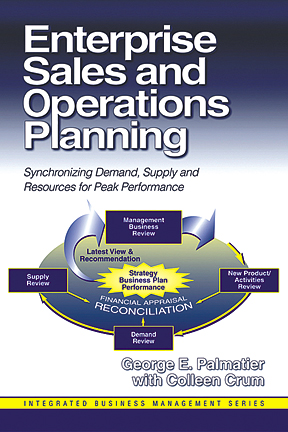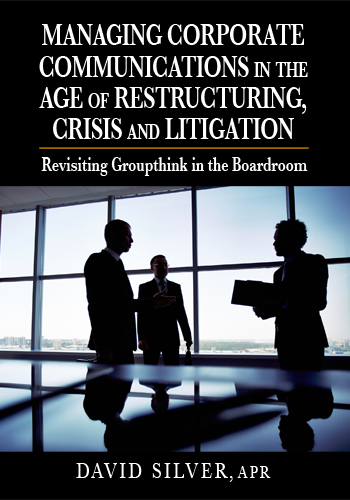Managing Corporate Communications in the Age of Restructuring, Crisis, and Litigation
Direct Price: $29.95
Revisiting Groupthink in the Boardroom
By David Silver
Hardcover, 6×9, 232 pages
ISBN: 978-1-932159-88-2
December 2013
LEARN & EARN: Get 4.4 PDUs in the PMI skill areas of Leadership or Strategic and Business Management Skills
Description
Corporate executives, lawyers, and board of directors suffer from groupthink when confronted with a crisis, restructuring or litigation, which results in a communications meltdown that hurts a company’s number one asset—its reputation. This failure to understand how to communicate in distressed situations results in lost credibility and trust on a global basis in front of many target audiences: customers, employees, vendors, business partners, the media, analysts covering the company, lenders, bankers, regulatory agencies, and elected officials.
This book gives examples of corporations who failed to communicate in a crisis, litigation, or restructuring in this era of financial meltdowns. By analyzing real-life examples (Lehman Brothers, BP, Toyota, MGA/Mattel, etc.), it offers innovative solutions and communications strategies for decision makers to help avoid groupthink and keep good reputations intact. If you are a CEO, CFO, general counsel, board of director, or part of the C-suite, understanding how to communicate in a distressed situation is crucial. A public relations nightmare might be just around the corner. Be prepared!
Key Features
- Outlines failures in corporate communications that has brought down successful executives, ruined their reputations, exiled them from the boardroom and ultimately destroyed their companies
- Shows how to re-educate boardroom executives to avoid groupthink and embrace critical reasoning to create innovative solutions when planning your communications strategies amid a crisis, restructuring or litigation
- Explains how independent intelligence gathering is crucial for executives during a distressed situation when formulating successful communications tactics
- Details how to change educational curriculum in business and law schools so that communications becomes a critical important subject and not just a throwaway elective
- Illustrates how determining strategies in distressed situations helps prepare decision makers to communicate key messages to target audiences at all other times
- Teaches how to use the media when communicating during a crisis, why employees are your most important audience, and how to proactively train senior executives and board members to understand how the communications process works when confronting distressed situations
- WAV offers GAP VII: The Seventh Communication and Public Relations Generally Accepted Practices Study from the USC Annenberg School, a checklist for performing an internal communications audit, and a presentation on effectively communicating during a litigation — available from the Web Added Value™ Download Resource Center
About the author(s)
David Silver is the Chief Executive Officer of Silver Public Relations, a public relations and investor relations firm in Los Angeles focusing on crisis, litigation, and restructuring financial public relations for publicly traded companies and private corporations. He has counseled more than 1,000 national and global corporations and its boardroom executives in his 25 years as a financial public relations executive.
His proprietary crisis and litigation communications audits are sought out by corporations as he focuses on the cause-and-effect of corporate crises. He has written for a number of newspapers including the Los Angeles Times, the Los Angeles Herald Examiner, and the Daily Journal, has been profiled in the Leaders and Success page of Investor’s Business Daily, and has been interviewed by CBS national news and other network news media as a crisis and litigation public relations expert.
Table of Contents
Acknowledgments
Foreword
Introduction: Groupthink Revisited
Part I: Case Studies
Chapter 1: Managing Reputation in Distressed Markets
Chapter 2: Litigation and the Court of Public Opinion
Chapter 3: The BP Disaster in the Gulf & Rampant Groupthink in the C-Suite
Chapter 4: Leading by Example: Steve Jobs and Effective Corporate Communication at Work
Part II: Theories & Paradigms
Chapter 5: The Role of Communication Theories
Chapter 6: The Evolution of Public Relations into the PR-IR Nexus
Part III: Remaking Corporate America
Chapter 7: Anatomy of a Crisis
Chapter 8: The Communications Audit
Chapter 9: Reeducating Corporate America
Chapter 10: Effective Communication for Litigation, Mergers, and Acquisitions
Conclusion
Bibliography
Index
Reviews
David Silver has written a highly readable primer that is a must for C-Suite executives. Silver makes the powerful case that if corporations do not properly communicate to confront and manage crises, the consequences can be embarrassing, expensive, and sometimes fatal.
—Stephen G. Moyer, author of Distressed Debt Analysis, former Portfolio Manager, PIMCO
This book reviews reputational management issues, litigation conflicts, and the execution of effective internal and external communications campaigns. When faced with any of these issues, explore the thoughtful examinations found in these pages for expert guidance.
—Edward W. Wedbush, Founder and President of Wedbush Securities
“Silver highlights the problems that usually brilliant CEOs who fail miserably in these situations; and it has pervaded corporations and financial institutions for decades. He looks at the problems afflicting corporate America with its “no comment” or evading the press in a crisis or litigation.
This new book will serve as a model for the correct way to handle crisis and litigations public relations issues, since the fourth estate is the ultimate gatekeeper to reputations in the court of public opinion. He also provides his proprietary communications audit that helps in the investigation and intelligence-gathering process that allows boardroom executives to be better prepared in minimizing the risk factor.”
—Paul Wiener
Related products
-

Aircraft Finance
Retail Price: $99.95Direct Price: $89.95 Add to cart -

Demand Management Best Practices
Retail Price: $54.95Direct Price: $49.95 Add to cart -

Winning E-Learning Proposals
Retail Price: $64.95Direct Price: $54.95 Add to cart -

Enterprise Sales and Operations Planning
Retail Price: $54.95Direct Price: $49.95 Add to cart -

Managing Business Analysis Services
Retail Price: $54.95Direct Price: $44.95 Add to cart

